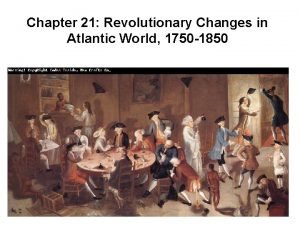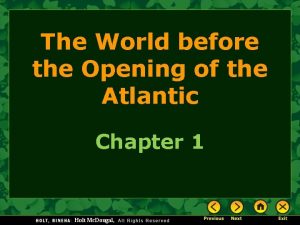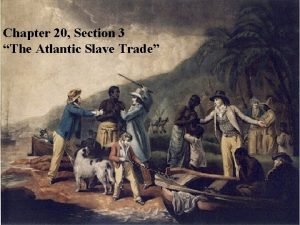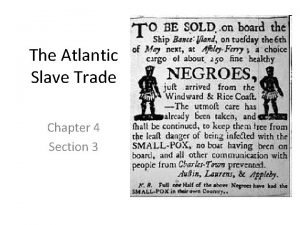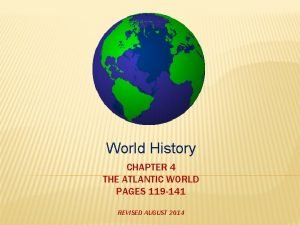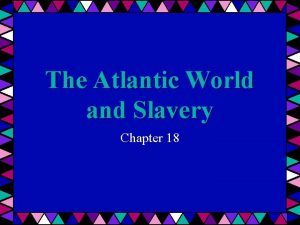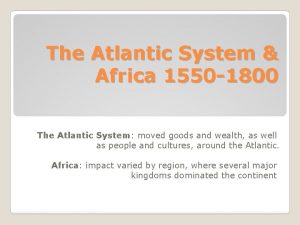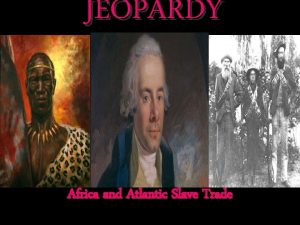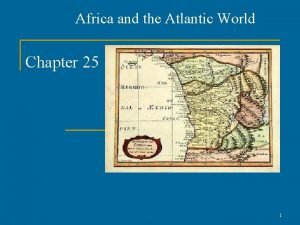Africa and the Atlantic World Chapter 26 pages









- Slides: 9

Africa and the Atlantic World Chapter 26 pages 697 -720

Warm-up 10/30 • Do you know what Santeria is?

Historical Context – 1450 -1750 CE • Islam: North Africa, Sub-Saharan Africa, Swahili coastal states • Trade networks • Sub-Saharan • Indian Ocean basin • Exporting slaves, ivory, gold • American foodstuffs • Cassava (Manioc), maize, peanuts • Leads to population explosion • Increased by 1/3 in just 100 -years • Portuguese • Coastal trading cities • South Africa: Dias 1488, Vasco Da Gama 1499 • Swahili city-states

Atlantic Slave Trade • Between 1650 -1860 CE, approx. 16 million slaves taken to New World (4 -million die) • Europeans buy slaves at coastal cities (Example: Angola) • Coastal African states prosper from slave trade (Example: Kingdom of Kongo) • Middle Passage: ¼ didn’t survive • Triangular Trade • Slaves from Africa to New World • Raw materials to Europe • Manufactured goods to Africa and Americas


Social Impact of Slave Trade - Africa • Loss of labor: 2/3 of slaves were young males • Example: By the late 18 th century women made up 2/3 of the population of Angola • Encouraged warfare between African tribes and states • Introduction of firearms

Social Organization – New World • Plantations and Haciendas • Small numbers of Europeans or Euro. Americans: supervising and governing • Large numbers of Africans or Africa— Americans: physical labor • Cash Crops • Sugar • Tobacco • Later Cotton • Many slave revolts – Maroons • Slavery key to economic development

Cultural Interactions • Creole Languages – blend of African and European • Many African slaves converted to Christianity • Syncretic Faiths (inspired by Christianity): Vodou Haiti, Santeria in Cuba, and Candomble in Brazil • Cuisines: African slaves introduced rice and okra to New World • Gumbo

End of Slavery • Moral = Christianity • Political = American and French Revolutions: “Life, liberty, property” (Locke) • Economic = • Rebellions were costly • Slaves were not always productive • As supply of sugar increased; profits fell. Cost of slavery increased. • Factory wage labor more profitable • Factory workers spent money on consumer goods • More money in trade with Africa than slavery • Slavery abolished by the end of 19 th century in the Americas
 Ap world history chapter 25 africa and the atlantic world
Ap world history chapter 25 africa and the atlantic world Printed pages vs web pages
Printed pages vs web pages Chapter 21 revolutionary changes in the atlantic world
Chapter 21 revolutionary changes in the atlantic world Revolutions and national states in the atlantic world
Revolutions and national states in the atlantic world The world before the opening of the atlantic
The world before the opening of the atlantic Bacons rebellion apush
Bacons rebellion apush Chapter 17 atlantic revolutions and their echoes
Chapter 17 atlantic revolutions and their echoes Chapter 20 section 3 the atlantic slave trade
Chapter 20 section 3 the atlantic slave trade Atlantic revolutions in a global context
Atlantic revolutions in a global context Chapter 4 section 3 the atlantic slave trade
Chapter 4 section 3 the atlantic slave trade


